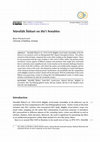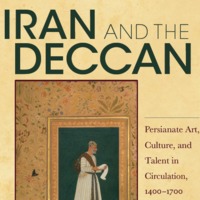Books by Reza Pourjavady

Entangeled Religions (Special Issue, Open Access), 2022
This special issue investigates the intellectual and religious contacts between Safavid Iran and ... more This special issue investigates the intellectual and religious contacts between Safavid Iran and Mughal India in the sixteenth and seventeenth centuries. Iran and North India witnessed fundamental cultural changes in the early modern period, which profoundly formed their new identity. The rulers of Iran at the time, the Safavids (1501–1722), proclaimed Shi’i Islam as the state religion; The Mughal emperors (1526–1858) fostered an environment in India where Islam, Hindu religions, Christianity and Zoroastrianism came more intensively in dialogue. Numerous syncretistic trends emerged from this entangled situation and the contacts affected the respective religions as well. Moderated Indian rulers invited, for example, the representatives of different religions to the court to dispute. They also supported translations of the Sanskrit religious texts into Persian. The open religious environment of Mughal India was for the Safavid intellectuals so attractive that many of them traveled or even migrated to India. Due to these migrations, scholastic teachings of Islamic theology started in major cities of India. Besides enhancing Mughal and Safavid intellectual thoughts, the interaction led to an emergence of religious thoughts in-between the two religious zones, as is the case of the new syncretistic philosophical and religious movement of Āẕar Kaivānīs. The volume covers several individual studies on topics related to the migration of Safavid scholars to the Mughal empire and its religious and intellectual outcomes.
Brill, 2018
During its Qajar period (1210–1344/1795–1925) Iran witnessed some lively and significant philosop... more During its Qajar period (1210–1344/1795–1925) Iran witnessed some lively and significant philosophical discourse. Yet apart from studies devoted to individual figures such as Mullā Hādī Sabzawārī and Shaykh Aḥmad al-Aḥsāʾī, modern scholarship has paid little attention to the animated discussions and vibrant traditions of philosophy that continued in Iran during this period. The articles assembled in this book present an account of the life, works and philosophical challenges taken up by seven major philosophers of the Qajar period. As a collection, the articles convey the range and diversity of Qajar philosophical thinking. Besides indigenous thoughts, the book also deals with the reception of European philosophy in Iran at the time.
Brill, 2006
The volume gives a detailed account of the available data of Ibn Kammūna’s biography, provides an... more The volume gives a detailed account of the available data of Ibn Kammūna’s biography, provides an outline of his philosophcial thought and studies in detail the reception of his thought and his writings among later Muslim and Jewish philosophers. An inventory of his entire œuvre provides detailed information on the extant manuscripts. The volume furthermore includes editions of nine of his writings.
Critical Editions of Arabic and Persian Texts by Reza Pourjavady
Brill, 2020
Maqālīd al-ʿulūm (Keys to the Sciences) is a significant source on definitions of Arabic scientif... more Maqālīd al-ʿulūm (Keys to the Sciences) is a significant source on definitions of Arabic scientific terms in the post-classical period. Composed by an anonymous author, it contains over eighteen hundred definitions in the realm of twenty-one religious, literary, and rational sciences. The work was dedicated to the Muzaffarid Shāh Shujāʿ, who ruled over Shiraz and its neighbouring regions from 759/1358 to 786/1384. The present volume contains a critical edition of Maqālīd al-ʿulūm based on its three extant manuscripts. In the introduction, the editors review previous scholarship on the text, present an overview of patronage at the court of Shāh Shujāʿ and identify some of the sources used by the author of the work. They suggest that the work in its structure mirrors Abū ʿAbdullāh Khwārazmī’s Mafātīḥ al-ʿulūm, completed in 366/976.
Iranian Institute of Philosophy & Institute of Islamic Studies, Freie Universität Berlin, 2007
Papers by Reza Pourjavady
Manuscript Culture 22, 2024
Publishing Information A Multiple-text Collection by Ẓahīr al-Dīn Mīrzā Muḥammad Ibrāhīm Edited b... more Publishing Information A Multiple-text Collection by Ẓahīr al-Dīn Mīrzā Muḥammad Ibrāhīm Edited by Sonja Brentjes Every volume of manuscript cultures has been subjected to a double-blind peer review process and is openly accessible at no cost on the CSMC website <https://www.csmc.uni-hamburg.de/publications/mc.html>. We would like to thank the German Research Foundation (DFG) for its generous support of the Cluster of Excellence EXC 2176 'Understanding Written Artefacts', which has made the publication of this journal volume possible.
Christian-Muslim Relations: A Bibliographical History. Volume 20. Iran, Afghanistan and Caucasus (1800–1914), 2023
Christian-Muslim Relations: A Bibliographical History. Volume 20. Iran, Afghanistan and Caucasus (1800–1914), 2023

Entangeled Religions, 2022
Nūrollāh Šūštarī’s (d. 1019/1610) Maǧāles al-moʾmenīn (Assemblies of the Believers) is an extensi... more Nūrollāh Šūštarī’s (d. 1019/1610) Maǧāles al-moʾmenīn (Assemblies of the Believers) is an extensive work on distinguished Shi’i figures throughout history. The author, trained in Safavid lands, composed this work while residing in the Mughal empire. There, he was associated with the court of Akbar (r. 963–1014/[1556]–1605). The present article introduces various aspects of Šūštarī’s project and examines what might have motivated him to undertake such a significant task. It also touches on the internal challenges found in the circles of the Shi’i scholars, with which the author was intellectually engaged, and discusses later critics of the work, who blamed its author for including in it many Sufi figures of the classical and post-classical period. Furthermore, the possibility that the composition of the Maǧāles caused its author’s death will be discussed. With his authorship of this work, Šūštarī was pioneering a trend of writing Shi’i bio-bibliographical works, to which many scholars contributed up until the twentieth century.
Ayman Shihadeh and Jan Thiele ed., Philosophical Theology in Islam: Later Ashʿarism East and West, Brill, 2020
Philosophy in Qajar Iran, edited by Reza Pourjavady, Brill, 2018
Philosophy in Qajar Iran, ed. Reza Pourjavady, Brill, 2018
Christian-Muslim Relations: A Bibliographical History, Volume 10, Brill, 2017

Oriens, 2017
Mīr Ḥusayn al-Maybudī (d. 909/1504) wrote a Persian treatise on philosophy titled The World-Revea... more Mīr Ḥusayn al-Maybudī (d. 909/1504) wrote a Persian treatise on philosophy titled The World-Revealing Cup ( Jām-i gītī-numā), in which he provided a survey of the views of recent philosophers on various worldly matters. This work of Maybudī acquired some fame in both the Safavid and the Ottoman empires. This is evident from numerous extant manuscripts of it and from the Persian commentary on it written by the
Ottoman scholar ʿUmar al-Challī (fl. 1077/1666). What is more, the text attracted the attention of some European scholars. Sometime after March 1619, a Scottish traveller and Orientalist, George Strachan, who traveled to Isfahan, made an interlinear Latin translation in his own copy of the work. Some years later, a Maronite scholar of Arabic literature, Abraham Ecchellensis (d. 1664), translated the text based on an Arabic version of it available to him, and then in Paris, in 1641, he published the dual Arabic-Latin translation. This article endeavors to demonstrate the significance of this work based on the broad nature of its reception.
Intellectual History of Islamicate World 3, 2015
Illuminationist Texts and Textual Studies: Essays in Memory of Hossein Ziai, edited by Ali Gheissari, John Walbridge and Ahmed Alwishah, Brill, 2018
Oxford Handbook of Islamic Theology, ed. Sabine Schmidtke, Oxford University Press, 2016
Part One: Ilkhanid and Post Ilkhanid Eras by Sabine Schmidtke and Part Two: Safavid Era by Reza P... more Part One: Ilkhanid and Post Ilkhanid Eras by Sabine Schmidtke and Part Two: Safavid Era by Reza Pourjavady











Uploads
Books by Reza Pourjavady
Critical Editions of Arabic and Persian Texts by Reza Pourjavady
Papers by Reza Pourjavady
Ottoman scholar ʿUmar al-Challī (fl. 1077/1666). What is more, the text attracted the attention of some European scholars. Sometime after March 1619, a Scottish traveller and Orientalist, George Strachan, who traveled to Isfahan, made an interlinear Latin translation in his own copy of the work. Some years later, a Maronite scholar of Arabic literature, Abraham Ecchellensis (d. 1664), translated the text based on an Arabic version of it available to him, and then in Paris, in 1641, he published the dual Arabic-Latin translation. This article endeavors to demonstrate the significance of this work based on the broad nature of its reception.
Ottoman scholar ʿUmar al-Challī (fl. 1077/1666). What is more, the text attracted the attention of some European scholars. Sometime after March 1619, a Scottish traveller and Orientalist, George Strachan, who traveled to Isfahan, made an interlinear Latin translation in his own copy of the work. Some years later, a Maronite scholar of Arabic literature, Abraham Ecchellensis (d. 1664), translated the text based on an Arabic version of it available to him, and then in Paris, in 1641, he published the dual Arabic-Latin translation. This article endeavors to demonstrate the significance of this work based on the broad nature of its reception.